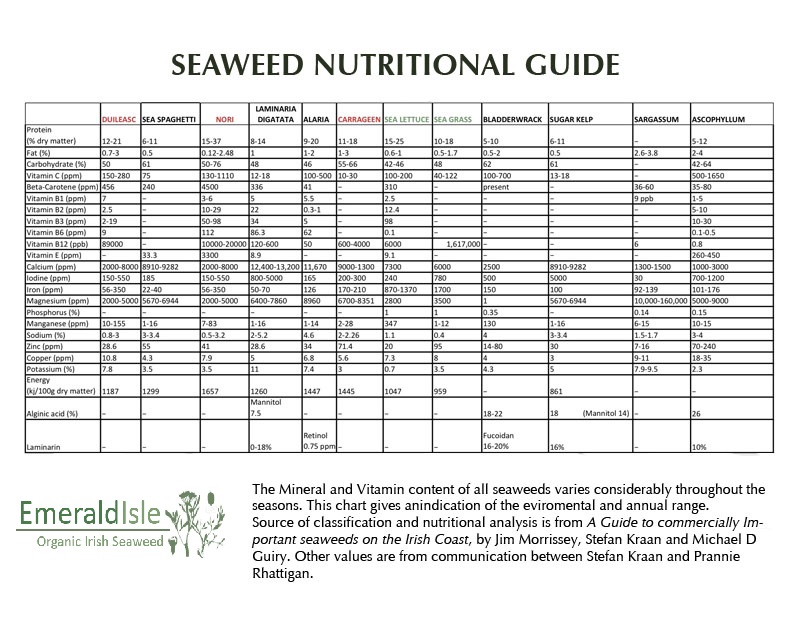
RESEARCH ON EDIBLE SEAWEED
http://www.bbcgoodfood.com/howto/guide/health-benefits-seaweed
http://nutritionfacts.org/video/which-seaweed-is-most-protective-against-breast-cancer/
Research on content of Iodine in Kelp Digitata by
Erwan Ar Gall, Frithjof C. Kupper, Bernard Kloareg
please see link:
http://www.researchgate.net/publication/240750337_A_survey_of_iodine_content_in_Laminaria_digitata
SEAWEED AS ANIMAL FEED
All Emerald Isle Seaweed has be tested for chemical, pesticides and water quality.
Research studies had been performed investigating the effect of using seaweed or macroalgae (even algae co-products) – as a part of the ruminant animal diets – on the animals production performance and health .The main feed market areas were microalgae may have a valuable application are summarized below:
For a long time, animals such as sheep, cattle and horses that lived in coastal areas have eaten seaweed,especially in those European countries where large brown seaweeds were washed ashore. Today the availability of seaweed for animals has been increased with the production of seaweed meal: dried seaweed that has been milled to a fine powder. Norway was among the early producers of seaweed meal,using Ascophyllum nodosum, a seaweed that grows in the eulittoral zone so that it can be cut and collected when exposed at low tide .
France has used Laminaria digitata, Iceland both Ascophyllum and Laminaria species, and the United Kingdom, Ascophyllum Because Ascophyllum is so accessible, it is the main raw material for seaweed meal and most experimental work to measure the effectiveness of seaweed meal has been done on this seaweed. The seaweed used for meal must be freshly cut, as drift seaweed is low in minerals and usually becomes infected with mould. The wet seaweed is passed through hammer mills with progressively smaller screens to reduce it to fine particles. These are passed through a drum dryer starting at 700-800°C and exiting at no more than 70°C. It should have a moisture level of about 15 percent. It is milled and stored in sealed bags because it picks up moisture if exposed to air. It can be stored for about a year.
Analysis shows that it contains useful amounts of minerals (potassium, phosphorus, magnesium, calcium,sodium, chlorine and sulphur), trace elements and vitamins. Trace elements are essential elements needed by humans and other mammals in smaller quantities than iron (approximately 50 mg/kg body weight), and include zinc, cobalt, chromium, molybdenum, nickel, tin, vanadium, fluorine and iodine. Because most often carbohydrates and proteins are not digestible, the nutritional value of seaweed has traditionally been assumed to be in its contribution of minerals, trace elements and vitamins to the diet of animals. In Norway, it has been assessed as having only 30 percent of the feeding value of grains.
Ascophyllum is a very dark seaweed due to a high content of phenolic compounds. It is likely that the protein is bound to the phenols, giving insoluble compounds that are not attacked by bacteria in the stomach or enzymes in the intestine. Alaria esculenta is another large brown seaweed, but much lighter in colour and in some experimental trials it has been found to be more effective than
Ascophyllum meal. It is this lack of protein digestibility that is a distinct drawback to Ascophyllum meal providing a useful energy content. In preparing compound feedstuffs, farmers may be less concerned about the price per kilogram of an additive; the decisive factor is more likely to be the digestibility and nutritive value of the additive. In feeding trials with poultry, adding Ascophyllum meal had no benefit except to increase the iodine content of the eggs. With pigs, addition of 3 percent Ascophyllum meal had no effect on the meat yield.However, there have been some positive results reported with cattle and sheep. An experiment for 7 years with dairy cows (seven pairs of identical twins) showed an average increase in milk production of 6.8 per cent that lead to 13 percent more income.
A trial involving two groups each of 900 ewes showed that those fed seaweed meal over a two-year period maintained their weight much better during winter feeding and also gave greater wool production.
–Click here for more research on seaweed animal feed
Benefits
-
Improve amino acids biologic activity in diet, contains 60 minerals including idine and 12 vitamins.
-
Improve immunity, increase conception and birth rates, reduce after birth retention
-
Decrease mastitis rate.
-
Increase feed intake, gains weight.
-
Improve the balance of feed nutrition, absorption of nutrition, promote metabolising, improves digestion.
-
In cows reduces milk fever, Increases milk butterfat levels, and increases iodine content in milk.
-
In horses and dogs gives shine to coat and helps condition the hooves
In Famine times, those potato crops that were fertilised with seaweed had no problems with potato blight, a fungus that affected Irish potato crops and led to the Great Famine in the mid-19th century.
Please note Emerald Isle Seaweed have developed our own dry room and all the seaweed products are made in one place. Our slow drying process ensure all the nutrients remain in the seaweed. We do not expose our seaweed to high temperatures, which would kill off many of the beneficial qualities of seaweed. This means our seaweed is nutrient dense.
Research on content of Iodine in Kelp Digitata by
Erwan Ar Gall, Frithjof C. Kupper, Bernard Kloareg
please see link:
http://www.telegraph.co.uk/education/universityeducation/8831727/Ten-life-changing-ideas-under-research-at-UK-universities.html?image=4
Therapeutic importance of sulfated polysaccharides from seaweeds: updating the recent findings, see link below
https://www.ncbi.nlm.nih.gov/pmc/articles/PMC3433884/
Patel S[Author]
Concerns on consuming carrageen, please see link below http://www.seaweed.ie/uses_general/carrageenans.php
